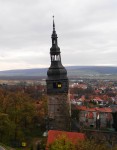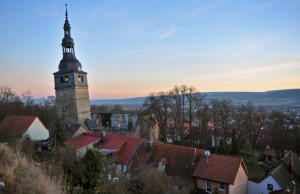 The funding cavalry has arrived to save the dangerously leaning tower of the Church of Our Dear Ladies on the Hill in the Thuringian spa town of Bad Frankenhausen. The 14th century bell tower, built on a chalk foundation over subterranean salt deposits that get washed out by the springs that put the Bad in Bad Frankenhausen, has been leaning precipitously since a 1908 landslide. It leans 15 feet eastward of the perpendicular, more than the Leaning Tower of Pisa.
The funding cavalry has arrived to save the dangerously leaning tower of the Church of Our Dear Ladies on the Hill in the Thuringian spa town of Bad Frankenhausen. The 14th century bell tower, built on a chalk foundation over subterranean salt deposits that get washed out by the springs that put the Bad in Bad Frankenhausen, has been leaning precipitously since a 1908 landslide. It leans 15 feet eastward of the perpendicular, more than the Leaning Tower of Pisa.
The Protestant Church in Central Germany (EKM), owner of the church for most of its life, tried to stabilize it several times over the years, but to no avail. Finally in December of 2011, the EKM decided to demolish the roofless, structurally unsound church and its leaning tower. The only chance of reprieve was if the city could raise the funds necessary to restore the tower, the EKM would sell the Church of Our Dear Ladies to the city for a token sum of €1 and chip in the money they had planned to spend on demolition (about €150,000).
It was a close call. By a vote of nine votes for, seven against and three abstentions, the Bad Frankenhausen city council agreed to the acquisition of the church. The estimated total cost of restoration was €1 million. Subtracting the demolition funds, that left the city with €850,000 to scare up. They put €50,000 into immediate stabilization work in early 2012, and then went to work trying to secure government funding. Without it, the city would not be able to raise the €800,000 and Bad Frankenhausen’s most recognizable landmark, symbol of the town just as the Leaning Tower is of Pisa, would have to be demolished for safety reasons.
 The city applied to the Thuringian Ministry of Construction for state funding, but were rejected. With time running out, Bad Frankenhausen threw a hail mary pass and applied to the National Urban Planning Projects, a new €50 million federal program to support city development projects of “national visibility, high quality, above-average investment volume or high potential for innovation.” The program received 271 applications, 24 from Thuringia alone, for a total of €900 million in requested funding.
The city applied to the Thuringian Ministry of Construction for state funding, but were rejected. With time running out, Bad Frankenhausen threw a hail mary pass and applied to the National Urban Planning Projects, a new €50 million federal program to support city development projects of “national visibility, high quality, above-average investment volume or high potential for innovation.” The program received 271 applications, 24 from Thuringia alone, for a total of €900 million in requested funding.
A jury of members of parliament, academics and urban planning experts selected 21 applications for project funding. The Bad Frankenhausen tower was one of only two winners from Thuringia. The stabilization of the tower will now be funded to the tune of €950,000. Mayor Matthias Strejc was particularly pleased to note the tower was considered a historic landmark of national importance by the federal government because the state government had sent them yet another rejection letter just a few days before they heard their application had been accepted by the National Urban Planning Projects.
The next step for the tower is research into the movement of the soil underneath it. Three holes will be dug, one 400 meters (437 yards) deep and two 70 meters (77 yards), and sensors inserted into the holes. The sensor readings will be viewable in real time by visitors to the tower’s information pavilion. The data will be submitted in a new report due by December 31st. Structural engineers will use that information to fine tune the stabilization plan which as of now involves building a reinforced concrete core in the basement of the tower and creating a steel corset structure on the outside.